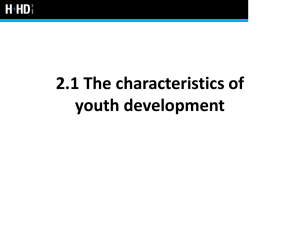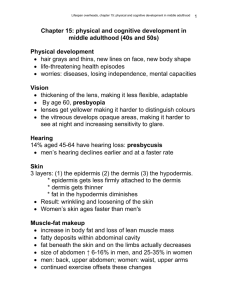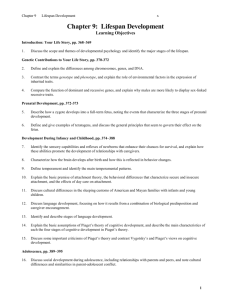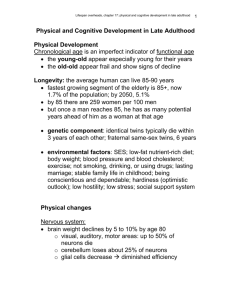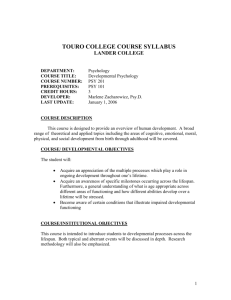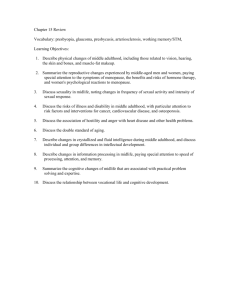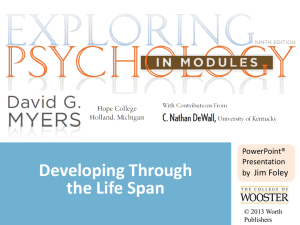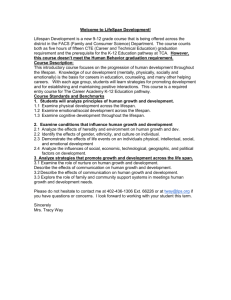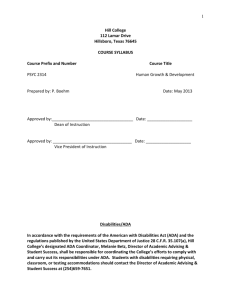Chapter 13: Physical and Cognitive Development in Early Adulthood
advertisement
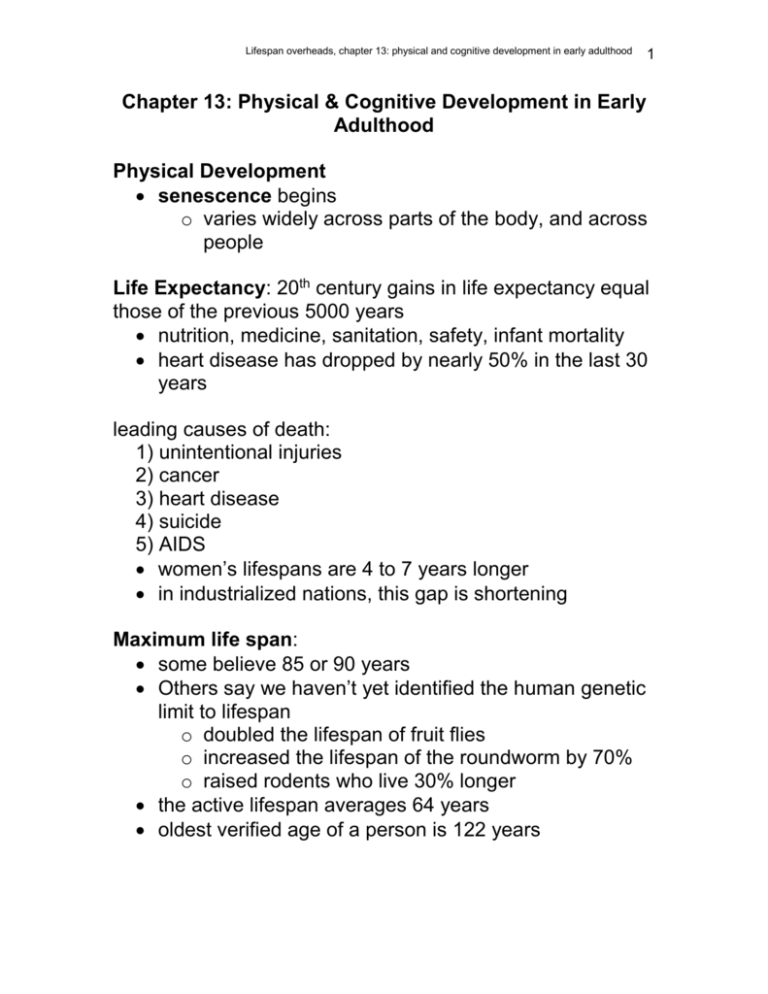
Lifespan overheads, chapter 13: physical and cognitive development in early adulthood 1 Chapter 13: Physical & Cognitive Development in Early Adulthood Physical Development senescence begins o varies widely across parts of the body, and across people Life Expectancy: 20th century gains in life expectancy equal those of the previous 5000 years nutrition, medicine, sanitation, safety, infant mortality heart disease has dropped by nearly 50% in the last 30 years leading causes of death: 1) unintentional injuries 2) cancer 3) heart disease 4) suicide 5) AIDS women’s lifespans are 4 to 7 years longer in industrialized nations, this gap is shortening Maximum life span: some believe 85 or 90 years Others say we haven’t yet identified the human genetic limit to lifespan o doubled the lifespan of fruit flies o increased the lifespan of the roundworm by 70% o raised rodents who live 30% longer the active lifespan averages 64 years oldest verified age of a person is 122 years Lifespan overheads, chapter 13: physical and cognitive development in early adulthood 2 Theories of aging Aging at the level of DNA and Body Cells: Theory 1: specific genes are programmed for the aging process. human cells allowed to divide in the laboratory have a lifespan of 50 +/- 10 divisions. with each duplication, they lose telomeres when they replace the telomeres they extend the lifespan of the cells Theory 2: cumulative effects of random events that damage genetic and cellular material. there is an increase in DNA breaks and deletions and other damage with age free radicals: genes for longevity may work by defending against free radicals Aging at the level of tissues and organs: cross-linkage of protein fibers a gradual drop in growth hormone (GH) associated with loss of muscle, addition of body fat, thinning skin immune system declines lead to increased risk of cancer, cardiovascular disease, infections Physical Changes cardiovascular and respiratory: o Only when people are exercising do we see a decline in performance with age. o Atherosclerosis: begins early in life, progresses in adulthood, and leads to serious problems in middle to late adulthood. Lifespan overheads, chapter 13: physical and cognitive development in early adulthood o Young/middle aged adults at low risk for heart disease: 40 to 60% reduced death rates o Lungs: during exertion, respiratory volume decreases and breathing rate increases with age. Motor performance: peaks between 20-30, then declines. If person remains active, performance drops only 2% per decade older people who participate in sports have twice the vital capacity as their peers who do not Immune system: T-cells and B-cells after age 20 the thymus starts to shrink; compromises immune response stress Reproductive capacity: female fertility declines sharply in the mid-30s (26% of women 35 to 44 cannot conceive naturally). Male fertility declines after 40, as the quantity of sperm in semen declines. Health overweight and obesity: o 22% are obese ; 54% are overweight o 4% of men and 8% of women have large weight gains between 25 and 34 o between 25 and 50, basal metabolic rate (BMR) gradually declines o excessive fat is associated with high blood pressure, atherosclerosis, diabetes, arthritis, cancer, early death 3 Lifespan overheads, chapter 13: physical and cognitive development in early adulthood 4 Exercise: only 23% of Americans engage in moderate physical activity for 20 minutes or more ate last 3 times a week. exercise fosters resistance to disease linked to reduced incidence of cancer helps prevent adult-onset diabetes reduces risk/severity of cardiovascular disease reduces anxiety and depression helps handle stress Substance abuse cigarettes: 25% of adult Americans smoke smoking in young people at college is on the rise average # of cigarettes smoked per day is 20 the earlier people start, the greater their daily intake the greater the daily intake, the greater the chance of premature death. Quitting: return to non-smoker disease-risk in 3-8 years Alcohol: 13% of men and 3% of women in the US are heavy drinkers. 1/3 of these are alcoholics men: alcoholism begins in teens/early 20s, worsens over time women: onset is in 20s/30s, more variable outcome Sexuality Heterosexuals: by 20, 80% have had sexual intercourse; by 22, 90%. Americans are far less sexually active than we are led to believe through media representations. Lifespan overheads, chapter 13: physical and cognitive development in early adulthood o o o o o o 5 50% aged 30-50 have had 5 + partners 71% report only one partner in the past year 3% (mostly men) report 5+ partners in past year 33% of 18-to-59-year-olds have sex twice a week 33% have sex a few times a month 33% have sex a few times a year or not at all As number of sex partners increases, satisfaction declines sharply. Sexual problems for women: lack of interest in sex (33%); inability to achieve orgasm (24%) for men: climaxing too early (29%); anxiety about performance (16%) Homosexuals 2.8% of men, 1.4% of women are homosexual/bisexual most Americans support equal job opportunities for gay men, lesbians, and bisexuals. heterosexual men judge homosexual men more harshly tend to be more educated than the general population, Sexual coercion: 14 to 25% of women have been victimized by rape Most (80%) are under age 30. Most knew their attacker well. 44% of college women reported sexual coercion; 19% of college men said they had gotten sex through force Lifespan overheads, chapter 13: physical and cognitive development in early adulthood 6 Men who engage in sexual assault: o believe in traditional gender roles o accept rape myths o have a desire to dominate their victims o claim that “she brought it on herself” o have trouble interpreting women’s social behavior strong gender stereotyping contributes to sexual coercion acceptance of violence in our culture also contributes women’s psychological reactions resemble those of survivors of extreme trauma 1/3 to ½ of rape victims are physically injured; 5% get pregnant Menstruation PMS: Usually experienced for the 1st time after age 20. 40% of women have some variant of symptoms. Psychological stress: mobilizes the body for action; can affect immune functioning; linked to several kinds of cancer, gastrointestinal problems Cognitive development Perry’s theory: college students’ cognitive perspectives changed as they were exposed to the complexities of university life and moved closer to adult roles. o Younger students: knowledge as separate units dualistic thinking o Older students: were aware of a diversity of opinions on almost any topic relativistic thinking Lifespan overheads, chapter 13: physical and cognitive development in early adulthood 7 Schaie’s theory: there are stages we go through reflecting our changing goals of mental activity o o o o The acquisitive stage The achieving stage The responsibility stage The reintegrative stage Labouvie-Vief’s theory: thinking moves from hypothetical to pragmatic o become aware of the constraints of everyday life o learn to accept inconsistencies as part of life o develop ways of thinking that thrive on imperfection and compromise Information processing: expertise and creativity Expertise: remember and reason more quickly and effectively they approach problems with underlying principles in mind, whereas novices approach problems in superficial ways fosters creativity creativity rises in early adulthood, peaks in the late 30s or early 40s, and gradually declines. exceptions to this trend: early starters and late bloomers College “culture shock” 75% of high school graduates enroll in higher education Lifespan overheads, chapter 13: physical and cognitive development in early adulthood 8 Psychological impact of college: applying reason and evidence to problems identifying strengths and weaknesses of different sides of complex issues. greater self-understanding, enhanced self-esteem, firmer sense of identity determined by how involved the person gets in academic and nonacademic activities; and the richness and diversity of the college setting o residential living o extensive contact with faculty 40% drop out, most within the first year, many within the first 6 weeks. Vocational choice Selecting a vocation: 1. fantasy period (early and middle childhood) 2. tentative period (early/middle adolescence) 3. realistic period (late adolescence, early adult) Factors influencing vocational choice: Personality John Holland (1966): 1) the investigative person 2) the social person 3) the realistic person 4) the artistic person 5) the conventional person 6) the enterprising person Lifespan overheads, chapter 13: physical and cognitive development in early adulthood 9 Family people in higher SES homes select higher-status occupations; those in lower-SES homes select lowerstatus occupations. parental pressure to do well and encouragement toward high-status occupations predict beyond SES Teachers: 39% of college freshmen rate a high school teacher as the most important impact on their choice of field of study. Gender stereotypes while the % of women in “masculine” careers has increased, it still falls well short of equality. women remain heavily concentrated in traditionally feminine professions girls’ grades are overall higher than boys’ in secondary school, but girls are less confident in their ability and more likely to underestimate their achievement. during college, their career aspirations decline further women constitute 9% of engineers and physicists
